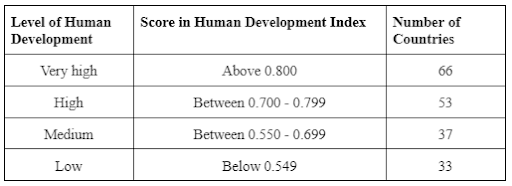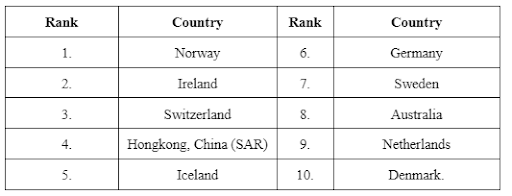Human development refers to the positive growth and changes in human habitation and livelihood. The human development has a huge impact on the quality of people’s life, such as their dignity, opportunities, freedom, etc.
Being an important topic, human development is discussed widely and is featured in the General Studies I section of the UPSC syllabus.
This article gives a good understanding of the topic, human development from the IAS Exam point of view.
Growth and Development
- Both growth and development refers to the changes over a period of time. Growth is quantitative and it may be either positive (showing an increase) or negative (depicting a decrease).
- Development is qualitative change which is always positive. Development takes place when growth is positive. Yet, positive growth does not necessarily result in development. Development occurs when there is positive change in quality.
- If the population of a city increases from one lakh to two lakhs, it is growth. However, if the facilities like housing, provision of basic facilities and other characteristics remain same, then the growth has not led to the development of the city.
- Earlier, a country’s development was measured in terms of its economic growth, though this growth did not really mean much change in the lives of most people. The quality of life people enjoy in a country, the opportunities they have and the freedom they enjoy are important aspects of a country’s development.
- The concept of human development was introduced by Dr Mahbub-ul-Haq (Pakistani economist) who created the human development index in 1990. According to him, development is all about enlarging people’s choices in order to lead long and healthy lives with dignity. People are central to all development under this concept. The United Nations Development Programme has used his concept of human development to publish the Human Development Report annually since 1990.
- Nobel Laureate Prof Amartya Sen saw an increase in freedom (or decrease in unfreedom) as the main objective of development. His work explores the role of social and political institutions and processes in increasing freedom.
Four Pillars of Human Development –
The four pillars of human development are-
- Equity – It means that equal opportunities must be made available to people irrespective of their race, income, gender and caste.
- Sustainability – It means continuity in the availability of opportunities. All environmental, financial and human resources must be used keeping in mind the future. Misuse of any of these resources will lead to fewer opportunities for future generations.
- Productivity – It means productivity in terms of human work. It is people who are the real wealth of a country and the efforts to increase their knowledge or provide better health facilities will result in better work efficiency.
- Empowerment – It refers to the power to make choices and this comes from increasing freedom and capability. The empowerment of socially and economically disadvantaged groups is of special importance.
Approaches to Human Development –
The important approaches of looking at the problem of human development are-
- Income Approach- This is an old approach to human development. Higher the level of income, the higher is the level of human development. Human development is directly related to income.
- Welfare Approach – In this approach, the government is responsible for increasing levels of human development by maximising expenditure on welfare (health, education, etc.). Here, humans act as beneficiaries of all developmental activities.
- Basic Needs Approach – In this approach emphasis is laid on providing six basic needs- health, education, food, water supply, sanitation and housing. This approach was initially proposed by the International Labour Organisation (ILO).
- Capability Approach – This approach is associated with Prof Amartya Sen. The key to increasing human development is to build human capabilities in the areas of health, education and access to resources.
Measuring Human Development –
The United Nations Development Programme (UNDP) publishes the Human Development Report every year since 1990. It provides a rank wise list of all its members (countries) according to the level of human development. The Human Development Index and the Human Poverty Index are the two important indices to measure human development used by UNDP.
- Human Development Index (HDI) – The HDI ranks the countries based on their performance in the key areas of health, education and access to resources. The rankings are based on a score between 0 – 1.
- To access health, the indicator chosen is the life expectancy at birth.
- The adult literacy rate and the gross enrolment ratio represent access to education.
- Access to resources is measured in terms of purchasing power (in US dollars).
Each dimension is given a weightage of ⅓. The human development index is a sum total of weights assigned to all these dimensions. The closer the score to one, the greater is the level of human development. HDI is not considered to be the most reliable measure as it does not say anything about the distribution.
2.The Human Poverty Index (HPI) – This index measures the shortfall in human development. It is a non- income measure. The probability of not surviving till the age of 40, the adult literacy rate, the number of people who do not have access to clean water and the number of small children who are underweight are all taken into account to measure the shortfall in human development in any region. HPI is considered to be more revealing than HDI.
International Comparisons –
- International comparisons of human development reveal that the size of the territory and per capita income are not directly related to human development. Relatively poor countries have been ranked higher in terms of human development than their richer neighbours. Also, smaller countries often have done better than larger ones in human development. Despite having smaller economies, Sri Lanka, Trinidad and Tobago have higher rank than India. Within India, Kerala performs better than Punjab and Gujarat despite having lower per capita income.
- On the basis of human development scores, countries have been classified into four groups-

- Top ten countries ranked with high human development index are-

- Countries with high levels of human development invest more in the social sectors and are generally free from political turmoil and instability. Distribution of the country’s resources is also far more equitable.
- Countries with low levels of human development tend to spend more on defence rather than social sectors indicating that these countries have political instability and have not been able to initiate accelerated economic development.
- India was 126th in the Human Development Index as per Human Development Report 2006. According to the HDI report 2020, India has gone down to 131.
Human Development:- Download PDF Here
| Related Links | |||
| Total Fertility Rate | Infant Mortality & Replacement Rate | ||
| Maternal Mortality Rate | UPSC Geography Notes | ||
| Syllabus of Geography for IAS Exam | NCERT Geography Notes for UPSC Exams | ||
Comments